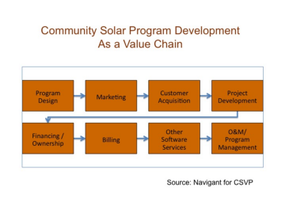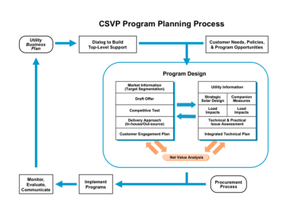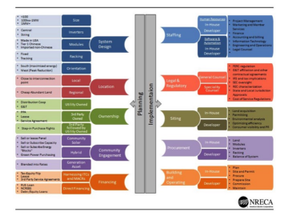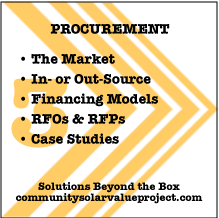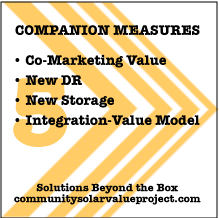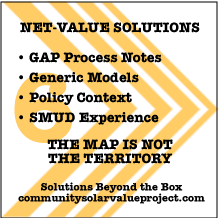Shared Solar Solutions
Program design for high-value shared solar: Start with one guiding process and options in five challenge areas
Over a three-year period, ending in 2018, the Community Solar Value Project (CSVP) reviewed a score of utility-drive community solar program design processes, working with public power and investor-owned utilities in the West, including Sacramento Municipal Utility District (SMUD) Public Service of New Mexico (PNM), member of the Platte River Power Authority (CO), Tucson Electric and many others. We believe most of this work continues to have strong value for any utility or for community stakeholders initiating a community solar program. In fact, the greatest changes since the CSVP culminated have been good ones: lower solar prices, greater acceptance of integrated-DER value and greater emphasis on strategic deployments, such as serving low-to-moderate income communities. |
In creating the CSVP program-design toolbox, including this web page and five others (see below), we reviewed program designs and their outcomes for approaches that yield extraordinary, high-value results. That led us again and again to think outside the box. In the end, the CSVP team set a goal to help program designers find high-value solutions in whichever challenge area that is most pressing to them, whenever those challenges arise.
What do the Solutions pages offer? First, we review different program-design processes, including our own, on the Process page on this site. We strongly suggest that your team work together to customize your process. Then keep that process keep it in mind as you proceed. It will serve as a tool for unifying diverse team members and as a checklist of key program-design considerations, no matter what challenges arise that call on you to make adjustments to your plan.
A good process diagram can be a good organizing tool, but sometimes the succession of boxes... the idealized steps... will not match up with your real-world, day-to-day need for solutions
Below, you will find a summary of the other pages in this Solutions toolkit.
What do the Solutions pages offer? First, we review different program-design processes, including our own, on the Process page on this site. We strongly suggest that your team work together to customize your process. Then keep that process keep it in mind as you proceed. It will serve as a tool for unifying diverse team members and as a checklist of key program-design considerations, no matter what challenges arise that call on you to make adjustments to your plan.
A good process diagram can be a good organizing tool, but sometimes the succession of boxes... the idealized steps... will not match up with your real-world, day-to-day need for solutions
Below, you will find a summary of the other pages in this Solutions toolkit.
Every utility planner’s process emphasizes a different aspect of the the challenge (time, budget, relationships, etc.). The CSVP process (center) emphasizes cross-departmental collaboration and the interplay between customer value and utility value. It seeks to create a high-value “win-win.”
1. The Process
Here we detail a solutions-oriented process for utilities to follow in developing their own community solar program plans. First, a report in presentation format: High-Value Community Solar: A Brief Guide to Utility Program Design. This guide summarizes lessons-learned and introduces the planning resources on this website. It is based on a one-day training/support module; details by request on our Contact page. Second, we introduce an archive of community solar program-design process and planning diagrams. This supports CSVP's recommendation that planners review various planning processes for ideas on how to customize their own. CSVP’s own process diagram highlights interdepartmental collaboration and opportunities for solar-plus integration. In working with utilities of all kinds, we have found that engaging other staff and stakeholders in your process is a top recommendation. A CSVP expanded blog-post offers practical tips and resources for addressing collaboration needs. A brief set of annotated resources on collaboration (aka, silo-busting) is included. Practical tips and case studies for community solar program design are captured in two webinars, which are archived with downloadable slides, for easy review.
|
2. Strategic Design
This challenge area introduces the benefits of local, community-scale solar, and of designing with strategic integration value in mind. We provide an introduction to strategic-design best practices, including ways to properly frame the decision between siting locally or acquiring the solar resource from a centralized, remote project. An abstract of the CSVP GAP analysis process offers a preview of economic considerations. GAP analysis is covered in more depth in the Net Value Assessment & Pricing section (6) of this toolkit. To show how one design element can be used in strategic applications, we offer a webinar and resource list on solar shade structures. Shade structures can be especially useful for community solar in urban areas, where siting is difficult. And, while not all low-income community solar program designs are strategic from the utility perspective, they may bring benefits that are highly valued by community stakeholders.
|
3. Procurement for Products & Services
Whether the community solar resource is utility-developed, acquired by power purchase agreement (PPA) or provided as part of a turnkey program package, the procurement process for community solar services and resources is a rich area for improving net value. Here, CSVP provides a community solar market landscape assessment, which serves as an overview of and a guide to early-stage planning decisions. In addition, we include CSVP's concise outsourcing decision key, a report in presentation format. We also provide an introduction to project financing models, suitable for investor-owned or consumer-owned utilities. A procurement resource guide offers direct links to publications with tips on developing a solar RFP. It is accompanied by a library of utility-led RFPs for various solar projects.
|
4. Target Market Research & Segmentation
Customer-driven program design is a relatively new approach for utilities, but it is required for success with community solar. For best-practice community solar programs, market research is a requisite first step that later it drives customer acquisition and retention. For this challenge area, CSVP provides a market research checklist and step-by-step guide to Market Research and Market Segmentation for Community Solar Program Success. References to other relevant resources are provided. A CSVP webinar is also linked to this topic, showcasing the guide and the fieldwork that CSVP team members have led with the Sacramento Municipal Utility District and other Utility Forum members.
|
5. Companion Measures
Interest in solar-plus-storage has boomed since CSVP first proposed addressing storage and demand response (DR) as companion measures for community solar. These companion measures do not have to be exclusively tied to the community solar offer, but planners for any community-scale solar project can benefit from this integrated program-design perspective. A modeling study of solar plus storage and DR, prepared with Utility Forum member Public Service Company of New Mexico (PNM), introduces the technical value of a solar-plus “triple play.” Planners can gain an in-depth, practical understanding from CSVP's guide to DR companion measures and guide to storage companion measures, which defines options on either side of the meter that can complement community solar. An annotated resource list is a useful companion guide. These are the first documents of their kind, taking the program planner's perspective to help deliver solar-plus innovations as scalable, saleable and replicable program options. Also included here: a webinar and presentations on solar-plus strategies that offer a practical way to start.
|
6. Net-Value Assessment & Pricing
This section provides detail on CSVP’s streamlined analytic process, which speeds the path from early-stage program design to competitive program pricing. It begins with an overview presentation and a paper on CSVP’s GAP economic analysis. This approach is characterized by a) framing with a program narrative that is brief and meaningful to utility decision-makers, and b) focusing on a limited number of benefits, in order to meet a solar cost target. That, in turn can support competitive program pricing. Three generic scenarios illustrate how this GAP analysis applies in different utility settings. A presentation and blog on pricing strategy clarifies the last step in this approach. In applies accepted pricing tools to create the final, competitive program offer. In addition, an expanded table of CSVP Pricing Case-Study Summaries tells how 12 community-solar programs have presented their pricing strategies. CSVP’s documentation of the SMUD plan from its work with the Sacramento Municipal Utility District is also included.
|



